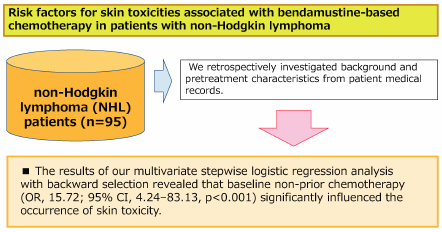- 著者
- Yoshimitsu Shimomura Tomotaka Sobue Ling Zha Tetsuhisa Kitamura Motoki Iwasaki Manami Inoue Taiki Yamaji Shoichiro Tsugane Norie Sawada
- 出版者
- The Japanese Society for Hygiene
- 雑誌
- Environmental Health and Preventive Medicine (ISSN:1342078X)
- 巻号頁・発行日
- vol.28, pp.19, 2023 (Released:2023-03-07)
- 参考文献数
- 47
- 被引用文献数
- 1
Background: The association between meat, fish, or fatty acid intake and acute myeloid leukemia (AML) and myelodysplastic syndrome (MDS) has been investigated in a few studies, and the results were inconsistent. In addition, most studies are mainly based on the United States and European countries, in which the dietary patterns differ from that in Asia. Therefore, the risk of AML/MDS from meat, fish, or fatty acid intake in Asia requires further exploration. The aim of this study was to investigate the association between AML/MDS incidence and meat, fish, or fatty acid intake using the Japan Public Health Center–based prospective study.Methods: The present study included 93,366 participants who were eligible for analysis and followed up from the 5-year survey date until December 2012. We estimated the impact of their intake on AML/MDS incidence using a Cox proportional hazards model.Results: The study participants were followed up for 1,345,002 person-years. During the follow-up period, we identified 67 AML and 49 MDS cases. An increased intake of processed red meat was significantly associated with the incidence of AML/MDS, with a hazard ratio of 1.63 (95% confidence interval, 1.03–2.57) for the highest versus lowest tertile and a Ptrend of 0.04. Meanwhile, the intake of other foods and fatty acids was not associated with AML/MDS.Conclusion: In this Japanese population, processed red meat was associated with an increased incidence of AML/MDS.
- 著者
- Mayako Uchida Yasuhiro Mori Kenta Akiba Moena Miyasaka Tatsuya Hirano Hiroaki Ikesue Yuki Yamaguchi Aoi Takano Nami Maegawa Yoshimitsu Shimomura Keiko Hosohata Nobuyuki Muroi Takayuki Ishikawa Tohru Hashida Tsutomu Nakamura
- 出版者
- The Pharmaceutical Society of Japan
- 雑誌
- Biological and Pharmaceutical Bulletin (ISSN:09186158)
- 巻号頁・発行日
- vol.43, no.10, pp.1577-1582, 2020-10-01 (Released:2020-10-01)
- 参考文献数
- 26
- 被引用文献数
- 2
Bendamustine plays an especially important role as a treatment for non-Hodgkin lymphoma (NHL). However, patients administered bendamustine alone or in combination with rituximab (BR) may experience drug-associated skin toxicities that can profoundly impact their health-related QOL through both physical discomfort and psychological distress. Moreover, worsening skin symptoms may lead to dose reduction or termination in the management of cancer chemotherapy. We retrospectively investigated patient backgrounds and pretreatment characteristics from medical records of NHL patients treated with bendamustine alone or BR therapy and identified predictive factors for skin toxicities at the start of chemotherapy. Patients were eligible for the study if they were 20 years older, diagnosed with NHL, and received bendamustine alone or BR therapy at the Department of Hematology, Kobe City Medical Center General Hospital, between April 1, 2011, and March 31, 2018. This study included 95 patients with newly diagnosed or refractory or relapsed NHL. Multivariate stepwise logistic regression analysis with backward selection revealed that baseline non-prior chemotherapy (odds ratio (OR), 15.72; 95% confidence interval (CI), 4.24–83.13, p < 0.001) was a significant factor influencing the occurrence of skin toxicity. Our results demonstrated that non-prior chemotherapy was a significant risk factor for skin toxicities in patients with NHL receiving bendamustine alone or BR therapy. No patient experience serious side effects of grade 3 or higher and that bendamustine is very useful as a first-line treatment.
